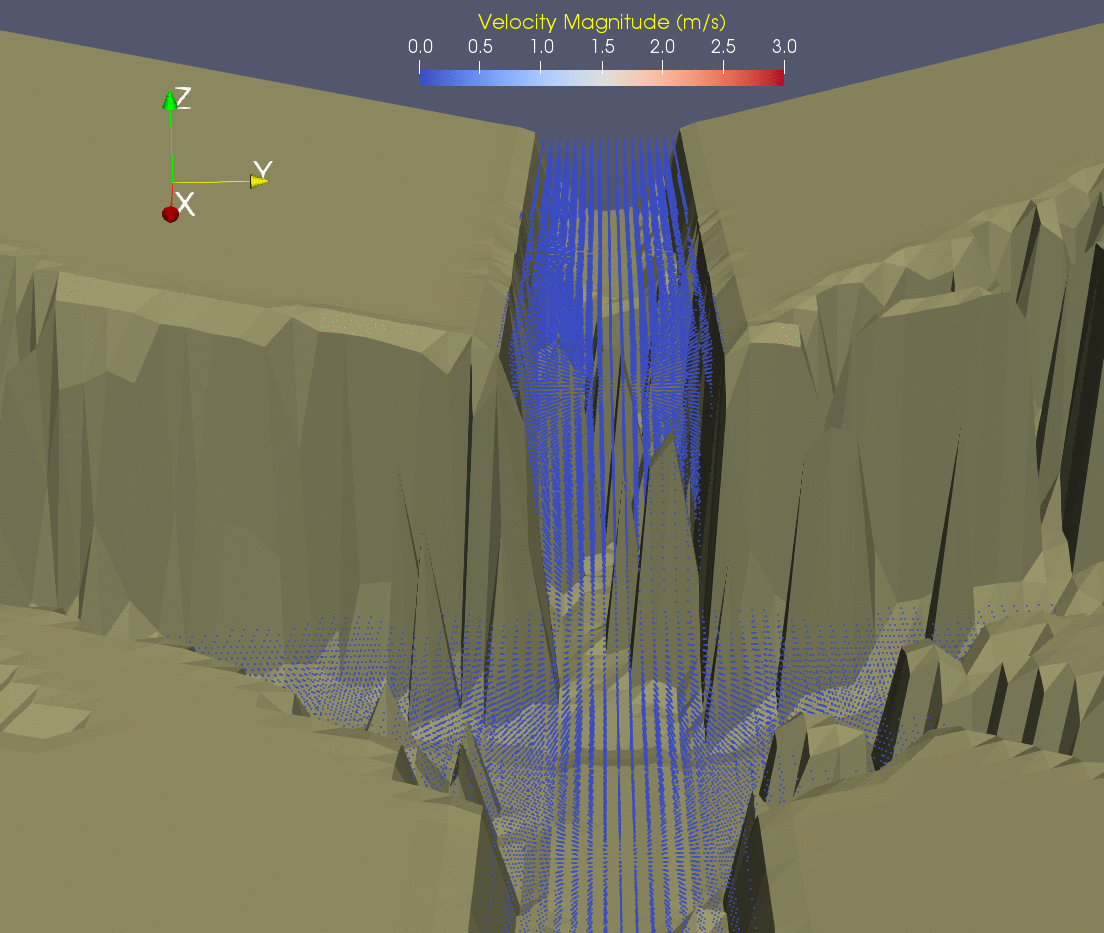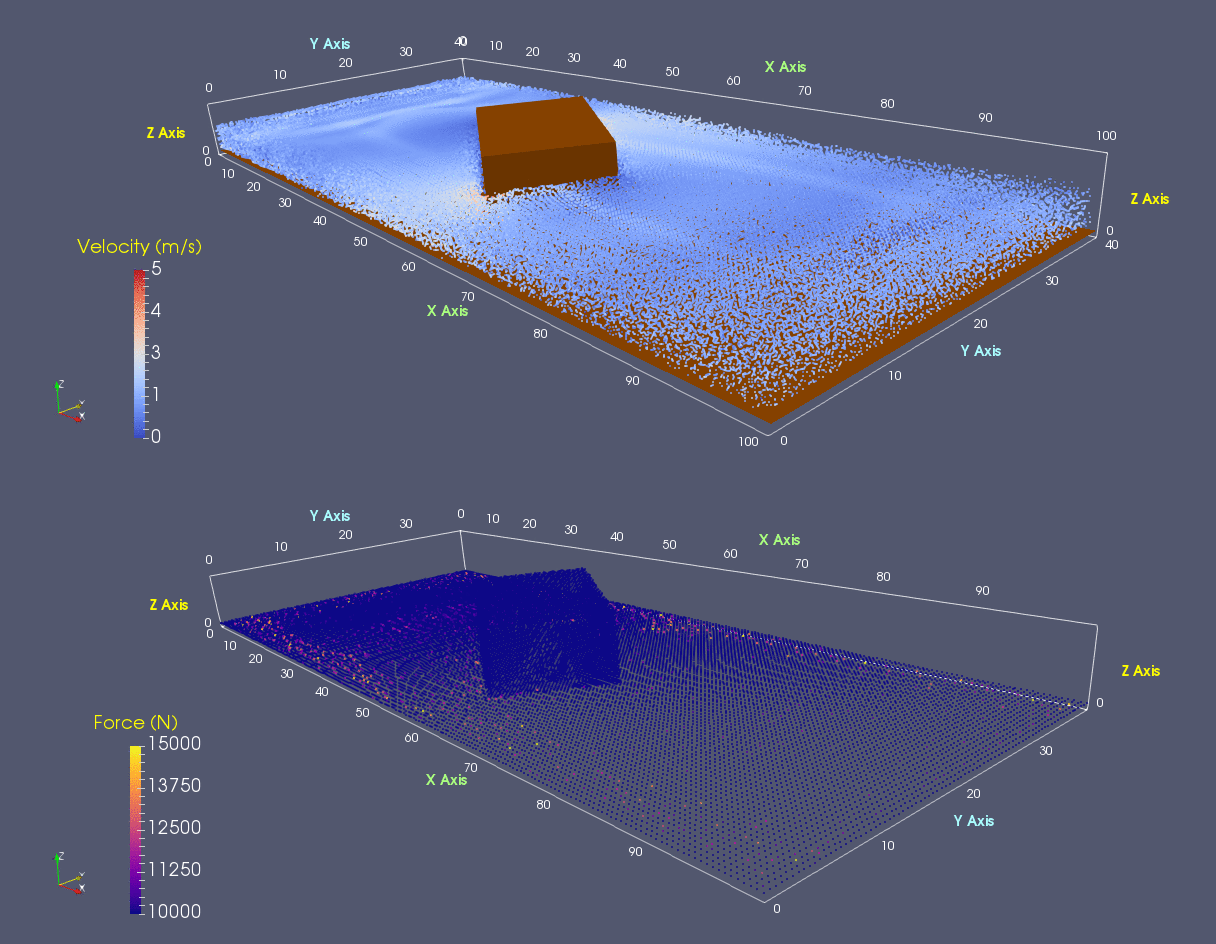Difference between revisions of "Smoothed Particle Hydrodynamics"
m |
|||
| (41 intermediate revisions by the same user not shown) | |||
| Line 1: | Line 1: | ||
| − | + | == Want to use Smoothed Particle Hydrodynamics (SPH) for your Earth Science Investigation? == | |
| − | |||
| − | |||
| + | Please refer to: [[DualSPHysics Guidelines for Earth Scientists]] | ||
| − | + | == Exploring the Dynamics and Kinematics of Rivers with Smoothed Particle Hydrodynamics (SPH) == | |
| + | ''[[User:Nick | Nick Richmond]], University of Maine'' | ||
| + | Smoothed Particle Hydrodynamics (SPH) provides a meshless solution for fluid mechanics in three dimensions. Unlike traditional computational fluid dynamics methods, SPH is capable of handling violent flows with complex surface dynamics, which makes SPH a useful tool for investigating the motions and forces associated with flow in Earth Systems. So far, I've used SPH for two main projects: | ||
| + | * [[Bedrock Channel Evolution | '''3D bedrock channel evolution with Smoothed Particle Hydrodynamics coupled to a Finite Element Earth''']] | ||
| + | * [[Penobscot River Hydraulics | '''Post-dam removal river hydraulics and the influence of derelict industrial logging infrastructure on modern aquatic habitat''']] | ||
{| class="wikitable" | {| class="wikitable" | ||
|- | |- | ||
| − | ! style="width: | + | ! style="width:330px" | Click on the animated gif to learn more about how we use SPH and Finite Element Analysis to study bedrock channel evolution. |
| − | + | ! style="width:330px" | Click on the animated gif to learn more about how we use SPH to study the effects of relict logging structures on aquatic habitat in Maine's Penobscot River. | |
|- | |- | ||
| + | | [[File:KnickpointMeanderVel01.gif|link=Bedrock Channel Evolution|700px]] | ||
| + | | [[File:BoomIsland01.gif|link=Penobscot River Hydraulics|700px]] | ||
|- | |- | ||
| − | + | | style="width:330px" | Here, water flows through an eroded knickpoint with several upstream meanders which develop as a result of preferential erosion of weak material. | |
| − | + | | style="width:330px" | Here, water flows around an idealized version of a relict logging structure known as a "boom island." | |
| − | |||
|} | |} | ||
| − | |||
| − | |||
| − | |||
| − | |||
| − | |||
| − | |||
| − | + | == Exploring the method of smoothed particle hydrodynamics (SPH) and its application to iceberg capsize dynamics == | |
| − | + | ''Lynn Kaluzienski, 9/20/2015, University of Maine'' | |
| − | |||
| − | + | Analytical solutions for problems in fluid dynamics are unavailable for most real world flows. The method of Smoothed Particle Hydrodynamics (SPH) was initially developed for astrophysical problems and has since been used to formulate approximate solutions for equations in fluid dynamics, chiefly the Navier Stokes solution for a weakly compressible fluid. SPH takes the innovative approach of replacing a fluid with an array of particles and solving the Navier Stokes equation on a particle by particle basis. A smoothing function is applied to each individual particle to determine the influence of its neighbors within a certain radius giving more weight to nearby particles. SPH is naturally a meshfree Lagrangian method, providing several benefits over former gridbased techniques in capturing surface accelerations and removing the need of tracking fluid boundaries. One difficulty with the SPH method is the need for a large quantity of particles to achieve the same precision as a gridbased approach. However, recent improvements in computational power such as the widespread use of graphic processing units (GPUs) have made SPH implementation feasible and computationally inexpensive. Several open source codes, such as DualSPHysics, make high resolution SPH simulations easily achievable on computers with multiple GPU processing units. Depending on complexity, several hundred thousand particle simulations can be achieved on the order of minutes to hours on a desktop computer. Largerscale models with millions to even billions of particles can be efficiently computed on supercomputers. The University of Maine SECS Numerical Laboratory currently has SPH simulations running on multiple GPUs. In addition, our collaboration with the Advanced Computing Group at Umaine will allow us to run increasingly complex and higher resolution simulations on one of their supercomputers in the near future. | |
| − | + | '''Supporting Literature: Crespo et al 2015, Monaghan 2012''' | |
| − | the force of gravity and begins to flow down the ramp. Once the fluid particles meet the boundary | + | {| class="wikitable" |
| + | |- | ||
| + | ! style="width:500px" | In this model a fluid is initially held in a square configuration along a sloped ramp with open boundaries on both sides. At the the first time step the fluid is allow to flow outward due to the force of gravity and begins to flow down the ramp. Once the fluid particles meet the boundary edge on the right they cross over to the left side of the ramp. During the first few time steps the fluid quickly moves to fill the void on the upper left hand side and crashes with slower moving particles creating a significant splashing effect and the formation of a standing wave. Throughout the simulation this standing wave begins to die out as the flow approaches a state of equilibrium. | ||
| − | + | Credits: [http://www.dual.sphysics.org DualSPHysics] | |
| − | + | '''[[SPH Supporting Animations|Supporting Animations]]''' | |
| − | + | '''[[Introductory SPH Iceberg-capsize Simulations]]''' | |
| − | + | ! {{#ev:youtube|CT239kMKBag}} | |
| − | + | |- | |
| − | + | |} | |
| − | |||
| − | |||
| − | |||
| − | |||
| − | |||
| − | |||
| − | |||
| − | |||
| − | |||
| − | |||
| − | |||
| − | |||
| − | |||
| − | |||
| − | |||
| − | |||
| − | |||
| − | |||
| − | |||
| − | |||
| − | |||
| − | |||
| − | |||
| − | |||
| − | |||
| − | |||
| − | |||
| − | |||
| − | |||
| − | |||
| − | SPH | ||
| − | |||
| − | |||
| − | |||
| − | |||
| − | |||
| − | |||
| − | |||
| − | |||
| − | |||
| − | |||
| − | |||
| − | |||
| − | |||
| − | |||
| − | |||
| − | |||
| − | |||
| − | |||
| − | |||
| − | |||
| − | |||
| − | |||
| − | |||
| − | |||
| − | |||
| − | |||
| − | |||
| − | |||
| − | |||
| − | |||
| − | |||
| − | |||
| − | |||
| − | |||
| − | |||
| − | |||
| − | |||
| − | |||
| − | |||
| − | |||
| − | |||
| − | |||
| − | |||
| − | |||
| − | |||
| − | |||
| − | |||
| − | |||
| − | |||
| − | |||
| − | |||
| − | |||
| − | + | '''For DualSPHysics users operating in the UMaine SECS Numerical Modeling Laboratory:''' | |
| − | + | Please see the [http://130.111.222.81/mediawiki-1.19.23/images/b/ba/DualSPH_User_Guide.pdf DualSPHysics User Guide] for a basic program tutorial. | |
Latest revision as of 15:59, 28 March 2019
Want to use Smoothed Particle Hydrodynamics (SPH) for your Earth Science Investigation?
Please refer to: DualSPHysics Guidelines for Earth Scientists
Exploring the Dynamics and Kinematics of Rivers with Smoothed Particle Hydrodynamics (SPH)
Nick Richmond, University of Maine
Smoothed Particle Hydrodynamics (SPH) provides a meshless solution for fluid mechanics in three dimensions. Unlike traditional computational fluid dynamics methods, SPH is capable of handling violent flows with complex surface dynamics, which makes SPH a useful tool for investigating the motions and forces associated with flow in Earth Systems. So far, I've used SPH for two main projects:
- 3D bedrock channel evolution with Smoothed Particle Hydrodynamics coupled to a Finite Element Earth
- Post-dam removal river hydraulics and the influence of derelict industrial logging infrastructure on modern aquatic habitat
Exploring the method of smoothed particle hydrodynamics (SPH) and its application to iceberg capsize dynamics
Lynn Kaluzienski, 9/20/2015, University of Maine
Analytical solutions for problems in fluid dynamics are unavailable for most real world flows. The method of Smoothed Particle Hydrodynamics (SPH) was initially developed for astrophysical problems and has since been used to formulate approximate solutions for equations in fluid dynamics, chiefly the Navier Stokes solution for a weakly compressible fluid. SPH takes the innovative approach of replacing a fluid with an array of particles and solving the Navier Stokes equation on a particle by particle basis. A smoothing function is applied to each individual particle to determine the influence of its neighbors within a certain radius giving more weight to nearby particles. SPH is naturally a meshfree Lagrangian method, providing several benefits over former gridbased techniques in capturing surface accelerations and removing the need of tracking fluid boundaries. One difficulty with the SPH method is the need for a large quantity of particles to achieve the same precision as a gridbased approach. However, recent improvements in computational power such as the widespread use of graphic processing units (GPUs) have made SPH implementation feasible and computationally inexpensive. Several open source codes, such as DualSPHysics, make high resolution SPH simulations easily achievable on computers with multiple GPU processing units. Depending on complexity, several hundred thousand particle simulations can be achieved on the order of minutes to hours on a desktop computer. Largerscale models with millions to even billions of particles can be efficiently computed on supercomputers. The University of Maine SECS Numerical Laboratory currently has SPH simulations running on multiple GPUs. In addition, our collaboration with the Advanced Computing Group at Umaine will allow us to run increasingly complex and higher resolution simulations on one of their supercomputers in the near future.
Supporting Literature: Crespo et al 2015, Monaghan 2012
| In this model a fluid is initially held in a square configuration along a sloped ramp with open boundaries on both sides. At the the first time step the fluid is allow to flow outward due to the force of gravity and begins to flow down the ramp. Once the fluid particles meet the boundary edge on the right they cross over to the left side of the ramp. During the first few time steps the fluid quickly moves to fill the void on the upper left hand side and crashes with slower moving particles creating a significant splashing effect and the formation of a standing wave. Throughout the simulation this standing wave begins to die out as the flow approaches a state of equilibrium.
Credits: DualSPHysics |
|---|
For DualSPHysics users operating in the UMaine SECS Numerical Modeling Laboratory:
Please see the DualSPHysics User Guide for a basic program tutorial.

